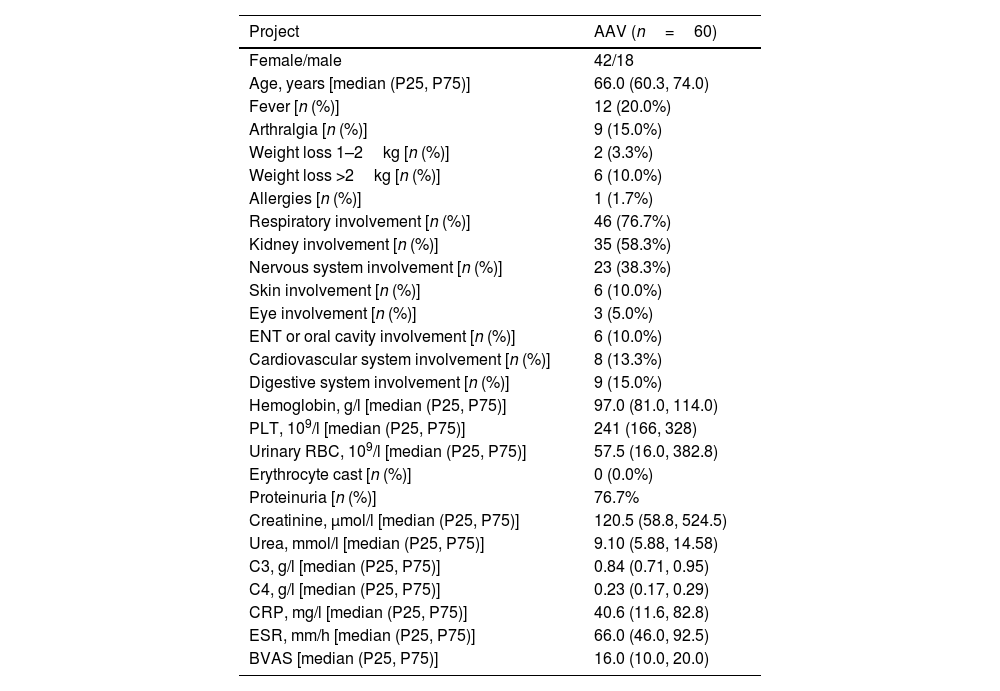The study aims to evaluate the role of anti-high mobility group box 1 (HMGB1) antibody and anti-moesin antibody in the diagnosis of antineutrophil cytoplasmic antibody (ANCA)-associated vasculitis (AAV) and its possible relationship with the different clinical manifestations.
MethodsThe study involved 60 AAV patients, 58 patients with autoimmune disease other than AAV and 50 healthy subjects. The serum levels of anti-HMGB1 and anti-moesin antibodies were determined by enzyme-linked immunosorbent assay (ELISA), and the second determination was made 3 months after treatment of AAV patients.
ResultsSerum levels of anti-HMGB1 and anti-moesin antibodies in AAV group were significantly higher than those in non-AAV group and HC group. The area under the curve (AUC) of anti-HMGB1 and anti-moesin in diagnosing AAV were 0.977 and 0.670, respectively. Anti-HMGB1 levels were significantly elevated in AAV patients with pulmonary involvement, while the concentrations of anti-moesin were significantly increased in patients with renal damage. Anti-moesin were positively correlated with BVAS (r=0.261, P=0.044), creatinine (r=0.296, P=0.024) and negatively correlated with complement C3 (r=−0.363, P=0.013). Besides, anti-moesin levels of active AAV patients were significantly higher than those in inactive patients. The concentrations of serum anti-HMGB1 could be significantly decreased after induction remission treatment (P<0.05).
ConclusionAnti-HMGB1 and anti-moesin antibodies play important roles in the diagnosis and prognosis of AAV, which may act as potential disease markers for AAV.
El estudio tiene como objetivo evaluar el papel del anticuerpo antigrupo de alta movilidad box 1 (HMGB1) y el anticuerpo antimoesina en el diagnóstico de la vasculitis asociada (VAA) a anticuerpos citoplasmáticos antineutrófilos (ANCA) y su posible relación con las diferentes manifestaciones clínicas.
MétodosEn el estudio participaron 60 pacientes con VAA, 58 pacientes con enfermedad autoinmune distinta de la VAA y 50 sujetos sanos. Los niveles séricos de anticuerpos anti-HMGB1 y antimoesina se determinaron mediante ensayo inmunoabsorbente ligado a enzimas (ELISA), y la segunda determinación se realizó tres meses después del tratamiento de pacientes con VAA.
ResultadosLos niveles séricos de anticuerpos anti-HMGB1 y antimoesina en el grupo AAV fueron significativamente más altos que los del grupo sin VAA y el grupo control sanitario. El área bajo la curva (AUC) de anti-HMGB1 y antimoesina en el diagnóstico de VAA fueron 0,977 y 0,670, respectivamente. Los niveles de anti-HMGB1 se elevaron significativamente en pacientes con VAA con afectación pulmonar, mientras que las concentraciones de antimoesina aumentaron significativamente en pacientes con daño renal. La antimoesina se correlacionó positivamente con puntuación de actividad vascular de Birmingham (r=0,261, p=0,044), creatinina (r=0,296, p=0,024) y se correlacionó negativamente con el complemento C3 (r=−0,363, p=0,013). Además, los niveles de antimoesina de los pacientes activos con VAA fueron significativamente más altos que los de los pacientes inactivos. Las concentraciones séricas de anti-HMGB1 podrían disminuir significativamente después del tratamiento de remisión de inducción (p<0,05).
ConclusiónLos anticuerpos anti-HMGB1 y antimoesina juegan un papel importante en el diagnóstico y pronóstico de VAA, que pueden actuar como marcadores potenciales de enfermedad para VAA.












